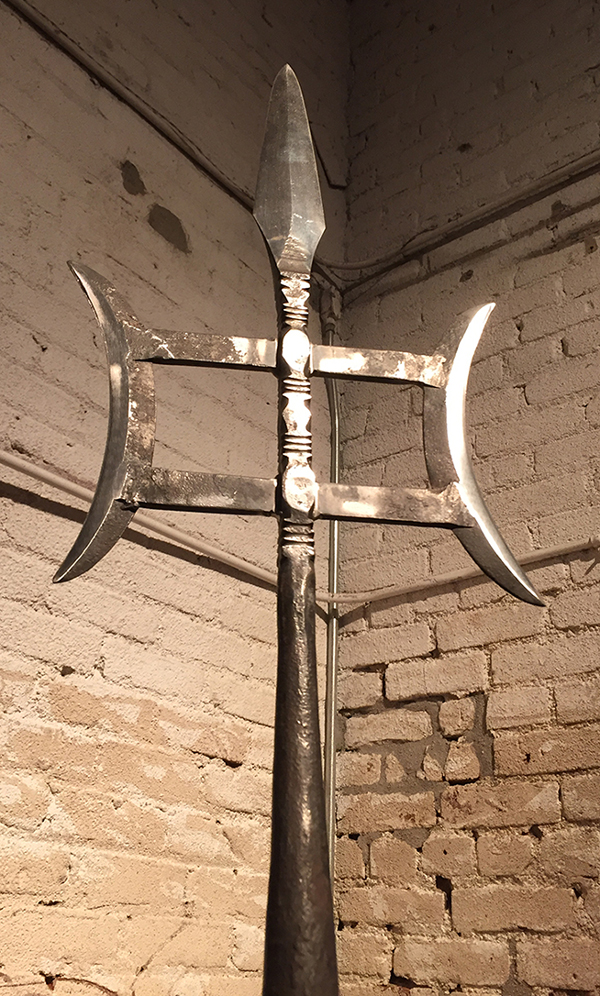
The Ji from Season 1.
EL REY Network's MAN AT ARMS: ART OF WAR begins each episode with a warning: "THE FOLLOWING SHOW FEATURES STUNTS PERFORMED EITHER BY PROFESSIONALS OR UNDER THE SUPERVISION OF PROFESSIONALS. NO ONE SHOULD ATTEMPT TO RE-CREATE OR RE-ENACT ANY STUNT OR ACTIVITY PERFORMED ON THIS SHOW." This is a very serious disclaimer. Obviously weapons are dangerous. Along with our team of War Room experts, we have a behind-the-scenes crew of stunt people working to keep everyone safe as well as medics on stand-by on the set. We even have one crewperson whose sole job is to handle the weapons. Even with all of these precautions, we've still had some accidental injuries. During our very first episode in Season 1, "Weapons of Kung Fu," Marko Zaror sustained an injury, and he's a professional stuntman as well as a martial arts expert. "In this show, we’re holding a blade that is for real," says Marko. "And if we make a mistake, we’re cutting a finger. We’re slashing skin. So that’s very powerful. You don’t get this feeling where you're shooting a movie for sure, because you know that a mistake could be a very big accident. And that’s why this show for me has been so new because I haven’t practiced with weapons a lot. And I don’t remember holding swords and stuff like that that are real. These things – you let it go and it could cut your foot. So that adrenaline is present through the whole show when we’re shooting, you know?"
Beyond our War Room stunt people, Marko and Crystal Santos, MAN AT ARMS: ART OF WAR Season 2 has two other professional stuntmen, Sifu Ray Copeland and Surawit Sae Kang, working behind the scenes as our stunt coordinators. What’s more, we also had stuntman Ardeshir Radpour as guest master this season. I got the chance to chat with them between takes and combined their interviews here for an easier read.

Surawit Sae Kang & Gene Ching.
GC: Many of our readers are interested in getting into stunt work. How did you guys get your starts?
RC: I started with a movie called Big Stan (2007) with Rob Schneider. I taught him with Guru Dan Inosanto. We used to go up to his home in Pasadena, and then Guru used to go on seminar circuit on the weekends so I would just drive up there by myself. So I did most of his training. Got him ready for the film. We had a little falling out. I was supposed to choreograph the movie but we had a little falling out. But they used all my choreography on the film anyway. But I did get credit on the film as his instructor for the movie.
SSK: Funny you ask. A stuntman fell on me. I was a ‘specialty background’, because I know how to handle firearms. And so the director asked me specifically to do the stunt, to fall. So the coordinator came and upgraded me to stunts. And a stuntman fell on me, doing one of the scenes, and we talked and became friends. Then we started training. And that’s how I got into the business. I got fell on.
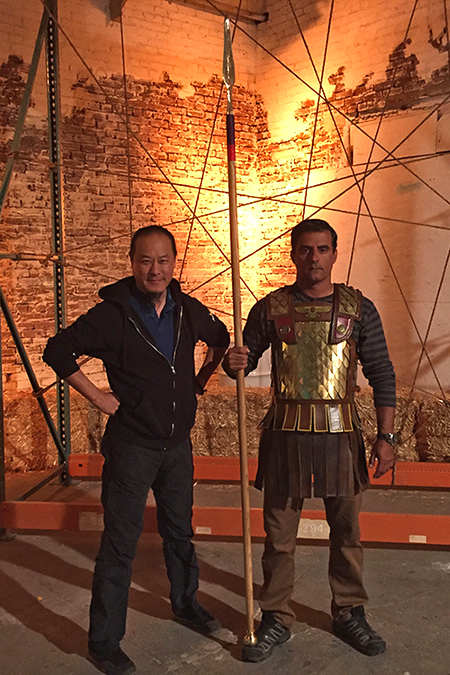
Gene Ching & Ardeshir Radpour.
AR: My stunt career was kind of accidental in that I had always done a little TV and stuff, training people with horses and archery. And then I would do some commercials just because of my horsemanship background or other interesting unique talents. But I had a company and as that was coming to an end, I had some opportunities to start working in shows. These dated archaic skills and talents that had been collected now became something that was an asset and valuable on a show, and not just something that I would kind of keep in my arsenal and never be able to use. Let’s just say mounted archery, or mounted lance-work or mounted sword-work.
GC: That's amusing. All three of you were martial artists first, and sort of fell into stunt work (literally for Sae).
RC: My background is Jeet Kune Do, so it’s very eclectic.
AR: So as a kid, I was heavy into a lot of Karate. It was Isshin Ryu and Shotokan. Then after that, I migrated into a lot of wrestling, which I was going to lead into Judo, but I never got into that because my horse career kicked in. While I was doing horses, I got introduced to a guy who happened to be one of the top Kendo instructors around, so I picked up Kendo from there. This was in L.A – Chuo Kendo Dojo. I started archery at the age of 5, which of course, at that point, I didn’t really know what I was getting into. I just picked it up as a novelty. But I would shoot pretty regularly. Later on, I coincidentally found out that that was the starting age for the Persians in their military service. And I’ve been shooting pretty heavily since then.
SSK: I did Muay Thai and Filipino. I did a little of everything pretty much. [laughs]
GC: And guns.
SSK: That was just a hobby. Martial arts plus hobby.
GC: How is working on MAN AT ARMS: ART OF WAR in comparison to typical stunt-work jobs?
RC: Night and day difference. Here I can see they’ve put a lot of thought into the kind of weaponry that they’ve built and putting the tests together. Whereas on set, we would just choreograph some fights and, you know, ham it up a little bit, get the right angles and you had a good fight scene. With this, there’s no room for error. You mess up, it’s going to show. And something bad’s going to happen if you don’t pay attention. If you’re dealing with bladed arts, the discipline and the focus has got to be on the Nth degree. Otherwise, you’re going to lose it, right?
AR: I love the show. I think it’s fun. It’s got an amazing crew and talent that’s here. It’s amazing to watch and learn new things and new techniques, get some input from people. And as far as testing the stuff, that’s incredible because it’s really rare that you get to test real deal weapons. Usually, it’s some prop stuff or some chintzy thing that somebody brought in, but this – they’re making this stuff pretty historically accurate. It’s nice. It’s incredible to see that firsthand.
I mean, how often do you get to do something like that outside of a Kendo Dojo? Here we’re getting used to testing weapons, and on a movie you’re engaging people and simulating real world stuff. The difference is, and I will tell you this – you can experience this firsthand here – and it is a transitional difficult thing for me because on films you’re always pulling. So you don’t make that contact. It’s a big no-no. Where here, you’re actually driving through to make that contact, so mentally I have to adjust myself to say, "Hey, I need to come through and actually deliver the killing blow," and then I have to readjust my brain and say, "Okay, well this one you can’t come through and make that killing blow."
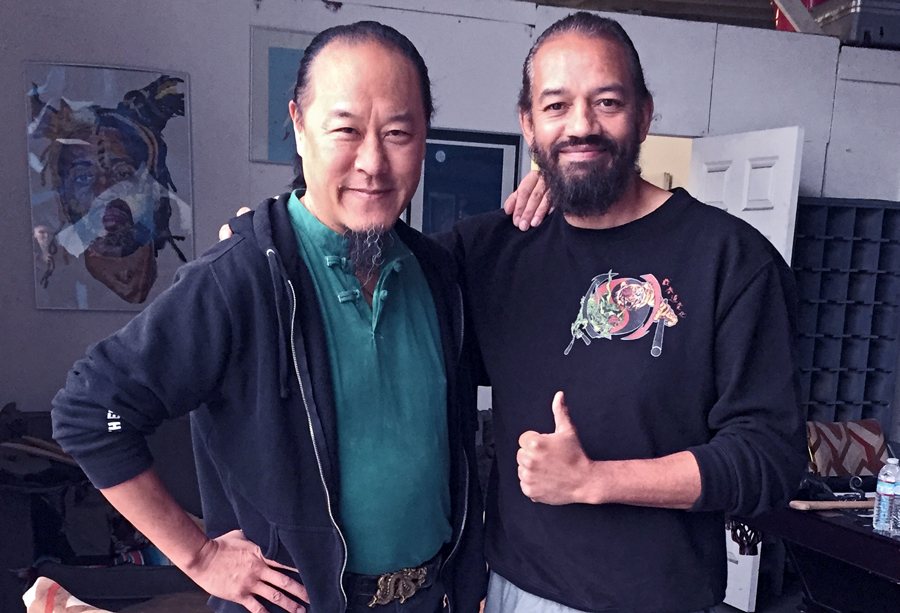
Gene Ching & Sifu Ray Copeland.
GC: Sae, we were talking about the stunt biz earlier and you had some great comments for our readers who might want to get into it.
SSK: My advice for martial artists that want to get into stunts – keep your moves clean. Really clean. Whatever moves you do, your punches, your kicks, your footwork – clean. And also, learn how to fall. Break the fall. Because if you’re a stuntman, you will do that a lot. For martial arts, or any kind of skill trade, study it. Understand it. Practice it. So when you have to do it, you don’t have to tell people you can do it. They can see that you can do it.
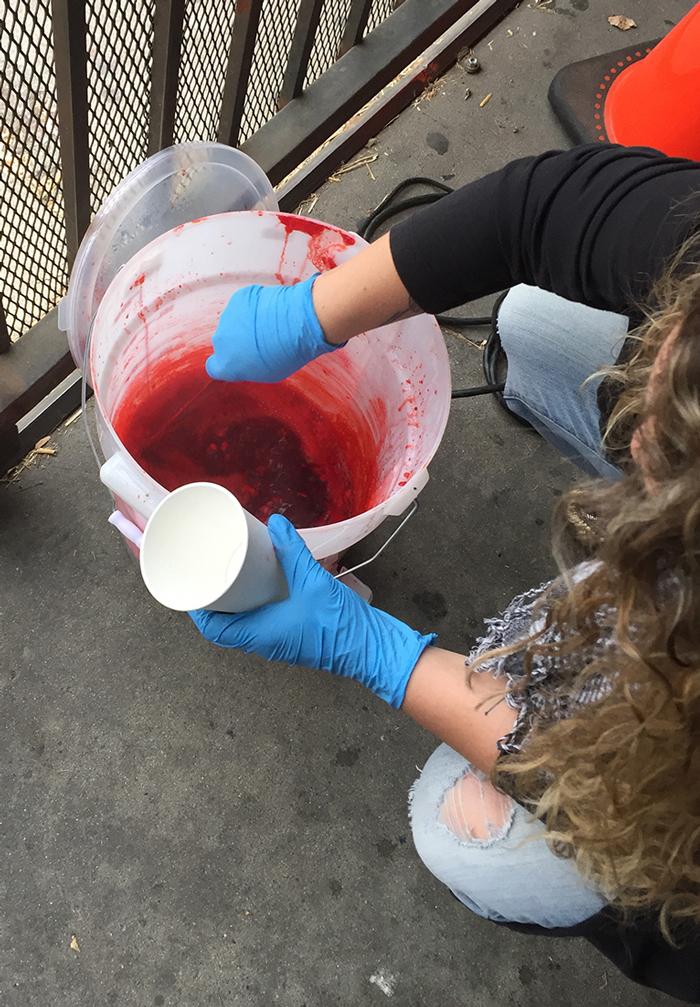
Bucket of blood.
You think the stunt work is so glamorous and all that, but actually, you guys never really hear when we hurt ourselves or anything like that. Yes, there’s some news that stuntmen die, but those are really big. On the regular basis, you guys never hear of that part…of the glam.
Now it’s a lot tougher than before because there’s so many people that know about it and know how to get into it now. So it’s gotten more competitive. Because now – wow – the newer generation, the kids are so talented. People are getting more and more talented. I was like, "Wow." It’s a good thing. It raises the standard. Because if not, we get low-quality performers. That looks very generic. Or no improvement. Nothing evolves. It’s good. A little challenge is good.
A lot of people are against doing background, but that’s how I got into my union. Because I have to go collect a union voucher. And being background, believe me, it’s terrible. It’s like the place you don’t want to be in. Background – like blur in the back, while they're focusing, shooting at the actor in the front. They’re the people walking in the back. Unless you’re super-talented, with luck and timing – they wanted you – you get Taft. Taft-Hartley is when you’re automatically able to join a union. But right now, to join the union, it’s pretty hefty. It’s about 3000-something right now.
GC: Thoughts on the show?
AR: I think this would go to anybody who practices any type of martial art or deals with a weapon. I think it’s very important for people to understand: there is a martial art and then there is an art of combat and war. They can be two totally different things. One is made so that you are focused on yourself and you develop techniques that help you balance yourself. And you learn a discipline and a respect, whether it is for that particular type of hand-to-hand combat or a weapon used. The other one is a killing art. And that’s a very different animal. There’s a lot less flourishing and jumping around. It’s a direct killing art and people need to make sure they don’t confuse those two so we can have a healthy respect for those two worlds because I see those two worlds and they collide a lot. You see it in archery. You see it in sword work. It’s nice. It’s neat to see both people doing what they do, but one is definitely made for killing and one is definitely made for an art form and I think we should respect that.
RC: Definitely check out the show because it’ll give you a different appreciation of the weapons-based systems that are out there.
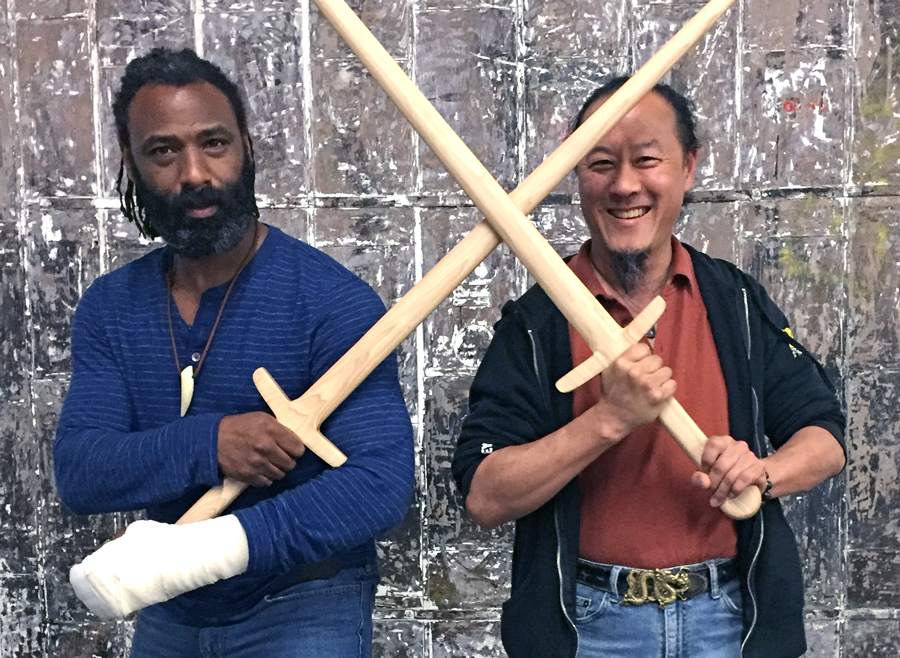
Da’Mon Stith & Gene Ching.
The Season 2 Accident
There was an accident during the filming of Season 2. Like with Marko’s injury in Season 1, it wasn’t crippling, but the decision was made to omit that scene from the final cut (no pun intended). Da’Mon Stith, the other Weapons Expert in the War Room, accidently cut himself. Emergency response was instant because the crew was well prepared. Our medic was on point and Da’Mon was rushed to the ER without delay. After some quick patching up, Da’Mon returned to the set later that day and was back in action for his next scene on the following day. We spoke about it later.
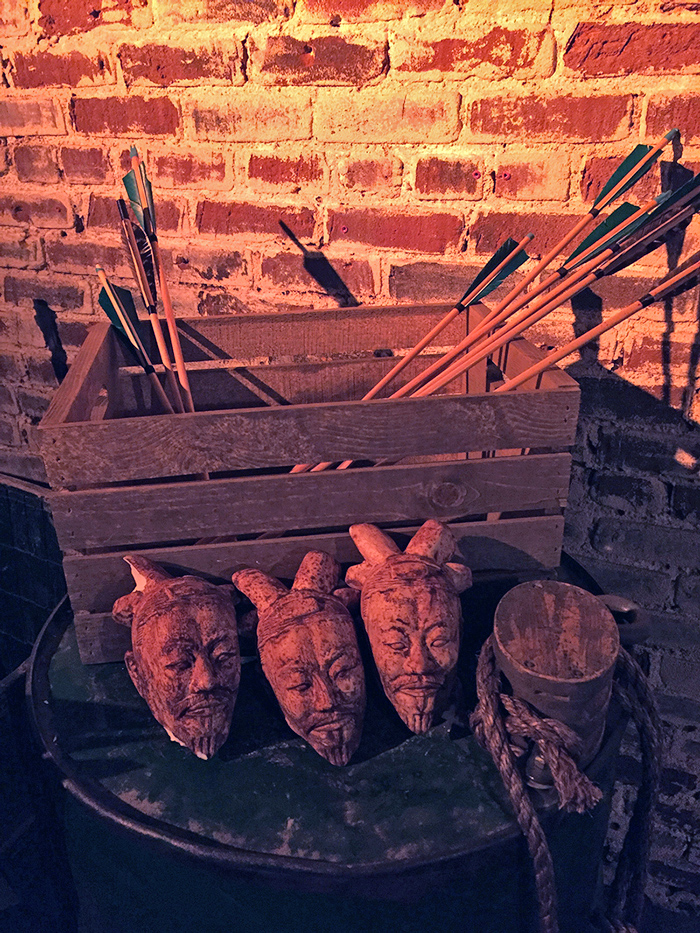
Chopped heads.
DS: So I got injured doing one of the tests. It was a really valuable lesson for me because as a martial artist used to working with weapons, it’s like any given day, it could happen to anyone else. So it’s important to be very careful while you’re cutting – to be very cognizant – because if it can happen to me, it can happen to anybody out there. So if you’re doing tests at home, I hope my – however many pints of blood I lost [laughs] – helps to prevent somebody from having an accident like that. I can just imagine someone doing that test by themselves and not having some help, not having people around to keep them safe. I can imagine things would go bad really fast. So if you’re doing this kind of stuff, please be careful. Please wear safety gear. Please have people around you. Maybe you shouldn’t even do the test. But it was an interesting moment. I think that we’ll all be wiser because of it.
One more thing I could say in regards to the show, and this is for the hardcore diehard serious, serious martial artist, because most people, they’re excited to see swords, see blades, and they’re excited to see them in action with people who spend their lives practicing. And they’re good with that. But then there’s the other segment, this is what they do, or maybe this is what they’re interested in, so they spend a lot of time like fine-tooth combing a lot of things. I would say remember, even though we’re all very passionate about what we do, we are in the position of presenting material that is hopefully entertaining and educational at the same time. And it’s a process. It’s a learning process for us. Even though we’re labelled as experts in our field, we’re still in the state of growing and progressing ourselves. So just be merciful [laughs].
New episodes of Season 2 of MAN AT ARMS: ART OF WAR are shown on Wednesdays on EL REY Network. STAY SHARP!
About
Gene Ching :
![]() For more exclusive coverage of MAN AT ARMS: ART OF WAR, read the WINTER 2019 issue of KUNG FU TAI CHI.
For more exclusive coverage of MAN AT ARMS: ART OF WAR, read the WINTER 2019 issue of KUNG FU TAI CHI.
![]() Print Friendly Version of This Article
Print Friendly Version of This Article
















